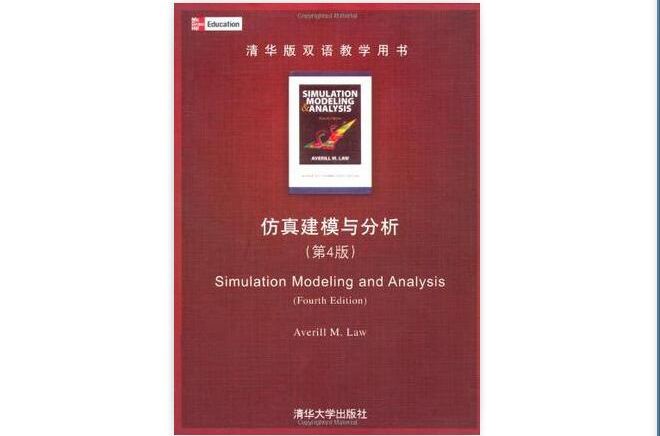內容簡介
《仿真建模與分析(第4版)(清華版雙語
教學用書)》自1982年首次出版以來,在世界範圍內得到廣泛採用,被譽為仿真領域的“聖經”。最新版(第4版)對離散事件系統仿真研究的所有重要方面給出了綜合性的最新論述,包括建模。
仿真軟體、模型校驗和確認。
目錄
Chapter 1 Basic Simulation Modeling
1.1 The Nature of Simulation
1.2 Systems, Models, and Simulation
1.3 Discrete-Event Simulation
1.3.1 Time-Advance Mechanisms
1.3.2 Components and Organization of a Discrete-Event Simulation Model
1.4 Simulation of a Single-Server Queueing System
1.4.1 Problem Statement
1.4.2 Intuitive Explanation
1.4.3 Program Organization and Logic
1.4.4 C Program
1.4.5 Simulation Output and Discussion
1.4.6 Alternative Stopping Rules
1.4.7 Determining the Events and Variables
1.5 Simulation of an Inventory System
1.5.1 Problem Statement
1.5.2 Program Organization and Logic
1.5.3 C Program
1.5.4 Simulation Output and Discussion
1.6 Steps in a Sound Simulation Study
1.7 Other Types of Simulation
1.7.1 Continuous Simulation
1.7.2 Combined Discrete-Continuous Simulation
1.7.3 Monte Carlo Simulation
1.8 Advantages, Disadvantages, and Pitfalls of Simulation
Appendix 1A: A Primer on Queueing Systems
1A.1 Components of a Queueing System
1A.2 Notation for Queueing Systems
1A.3 Measures of Performance for Queueing Systems
Problems
Chapter 2 Modeling Complex Systems
2.1 Introduction
2.2 List Processing in Simulation
2.2.1 Approaches to Storing Lists in a Computer
2.2.2 Linked Storage Allocation
2.3 A Simple Simulation Language: simlib
2.4 Single-Server Queueing Simulation with simlib
2.4.1 Problem Statement
2.4.2 simlib Program
2.4.3 Simulation Output and Discussion
2.5 Time-Shared Computer Model
2.5.1 Problem Statement
2.5.2 simlib Program
2.5.3 Simulation Output and Discussion
2.6 Multiteller Bank With Jockeying
2.6.1 Problem Statement
2.6.2 simlib Program
2.6.3 Simulation Output and Discussion
2.7 Job-Shop Model
2.7.1 Problem Statement
2.7.2 simlib Program
2.7.3 Simulation Output and Discussion
2.8 Efficient Event-List Manipulation
Appendix 2A: C Code for simlib
Problems
Chapter 3 Simulation Software
3.1 Introduction
3.2 Comparison of Simulation Packages with Programming Languages
3.3 Classification of Simulation Software
3.3.1 General-Purpose vs. Application-Oriented Simulation Packages
3.3.2 Modeling Approaches
3.3.3 Common Modeling Elements
3.4 Desirable Software Features
3.4.1 General Capabilities
3.4.2 Hardware and Software Requirements
3.4.3 Animation and Dynamic Graphics
3.4.4 Statistical Capabilities
3.4.5 Customer Support and Documentation
3.4.6 Output Reports and Graphics
3.5 General-Purpose Simulation Packages
3.5.1 Arena
3.5.2 Extend
3.5.3 Other General-Purpose Simulation Packages
3.6 Object-Oriented Simulation
Chapter 4 Review of Basic Probability and Statistics
4.1 Introduction
4.2 Random Variables and Their Properties
4.3 Simulation Output Data and Stochastic Processes
4.4 Estimation of Means, Variances, and Correlations
4.5 Confidence Intervals and Hypothesis Tests for the Mean
4.6 The Strong Law of Large Numbers
4.7 The Danger of Replacing a Probability Distribution by its Mean
Appendix 4A: Comments on Covariance-Stationary Processes
Problems
Chapter 5 Building Valid, Credible, and Appropriately Detailed Simulation Models
5.1 Introduction and Definitions
5.2 Guidelines for Determining the Level of Model Detail
5.3 Verification of Simulation Computer Programs
5.4 Techniques for Increasing Model Validity and Credibility
5.4.1 Collect High-Quality Information an Data on the System
5.4. Interact with the Manager on a Regular Basis
5.4.3 Maintain a Written Assumptions Document and Perform a Structured Walk-Through
5.4.4 Validate Components of the Model by Using Quantitative Techniques
5.4.5 Validate the Output from the Overall Simulation Model
5.4.6 Animation
5.5 Management's Role in the Simulation Process
5.6 Statistical Procedures for Comparing Real-World Observations and Simulation Output Data
5.6.1 Inspection Approach
5.6.2 Confidence-Interval Approach Based on Independent Data
……
Chapter 8 Generating Random Variates
Chapter 9 Output Data Anlaysis for a Single System
Chapter 10 Comparing Alternative System Configurations
Chapter 11 Variance-Reduction Techniques
Chapter 12 Experimental Design and Optimization
Chapter 13 Simulation of Manufacturing Systems
Appendix
References
……

